Iron deficiency is the leading cause of anemia, affecting around 25 % of the world’s population. Developing new foods naturally rich in iron from their ingredients is a promising approach to remedy this deficiency. However, iron absorption in the body is a complex phenomenon influenced by many factors.
Scientists from INRAE and ADIV in Clermont-Ferrand have investigated the bioavailability of iron using X-rays on the LUCIA beamline, aiming to design new foods for individuals with iron deficiencies.
Beyond the quantity of iron ingested, iron speciation — specifically, its oxidation state and its binding with other chemical elements — plays a crucial role in its absorption by the body. In food, iron exists in two forms: heme iron, mainly of animal origin (meat), and non-heme iron, found in both animal and plant products, which includes free iron ions (Fe2+ and Fe3+) and complex forms such as ferritin. Non-heme iron is the form most commonly consumed, but it is much less readily absorbed than heme iron because it interacts more easily with other compounds. Studies have shown that certain compounds can inhibit iron absorption, such as phytic acid (rich in phosphorus) and polyphenols, while others, like ascorbic acid and animal tissues containing sulfur peptides, can promote absorption.
In this context, research is emerging to develop ingredient combinations that maximize iron absorption by the body, such as combinations of animal and plant-based raw materials. Animal products, such as offals, have been shown to not only contain highly absorbable iron but also enhance the absorption of plant-based iron by reducing the impact of certain inhibitors when consumed together.
The goal of this study was to investigate the effect of storage on a layered, hybrid food 3D-printed and composed of liver and lentils, specifically looking at changes in iron speciation and its distribution within the product. To do this, cryogenic sections of this hybrid food were prepared after various storage periods, with or without oxygen (replaced by nitrogen, N2), then analyzed using an approach that combines X-ray fluorescence (XRF) mapping and X-ray absorption spectroscopy (XANES) on the LUCIA beamline (Figure 1).

Figure 1: Experimental setup for the study of iron in the hybrid food.
Synchrotron X-ray fluorescence microspectroscopy (µ-XRF) enabled researchers to map the distribution of iron in the food and simultaneously map phosphorus and sulfur. These analyses revealed a concentration of iron in the lentil amyloplasts in the presence of oxygen, as well as the colocalization of iron with sulfur and phosphorus (Figure 2). These findings suggest that iron may interact with ferritin, phytates, or sulfur-containing amino acids, potentially affecting its absorption.

Figure 2: Comparison of iron (Fe), phosphorus (P), and sulfur (S) profiles extracted from µ-XRF mappings in the foods depending on storage conditions (in the presence of nitrogen, N2-MAP, or oxygen, O2-MAP). The dashed line marks the plant/animal interface, with the plant part on the left and the animal part on the right.
In a second step, XANES spectroscopy identified and distinguished iron forms specific to animal and plant matrices. Results showed more reduced forms of iron in liver-based matrices and more oxidized forms in matrices containing lentils (Figure 3). After a few days of storage, µ-XANES spectroscopy revealed interactions between the animal and plant layers of the hybrid food, with the presence of reduced forms of iron similar to those found in the liver within the plant layer. Two hypotheses were formulated: a diffusion of animal-derived iron toward the plant portion, or a change in the iron speciation in the plant portion toward a more reduced form, which could explain improved absorption by the body.

Figure 3: Comparison of XANES spectra of iron for the animal and plant mixtures in the pre-peak region (energies ranging from 7105.2 to 7121.0 eV).
These findings provide new insights into the mechanisms of interaction between iron and other components, which should be considered when designing innovative iron-rich foods. This study also demonstrates the potential of hybrid foods that combine animal-based ingredients, especially from by-products, with plant-based ingredients as a means to combat iron deficiency. Complementary in vivo experiments would be particularly valuable to assess iron bioavailability from such food at the whole-body level.
Illustrative Image: Mapping of a cross-section of the hybrid food: plant portion (lentils) on the left and animal portion (liver) on the right — Image obtained by X-ray fluorescence spectroscopy on the LUCIA beamline (iron in red; phosphorus in green).
